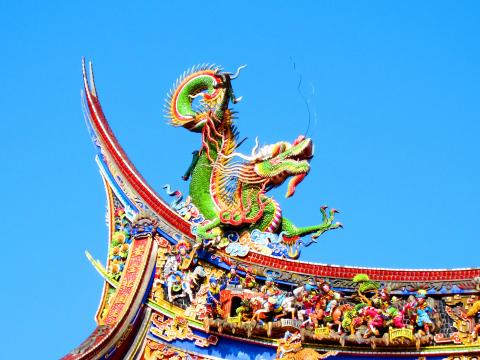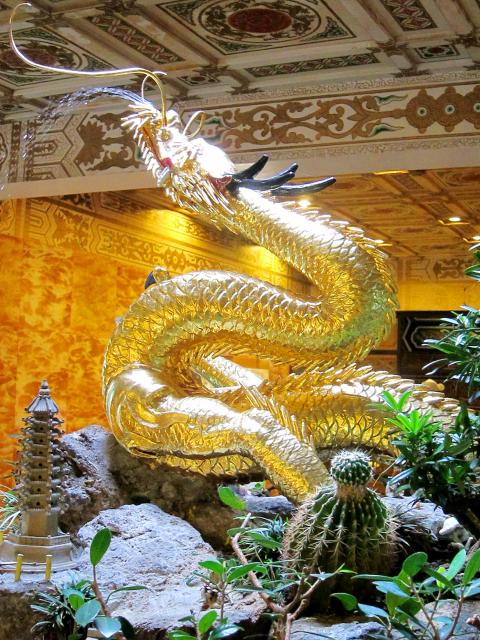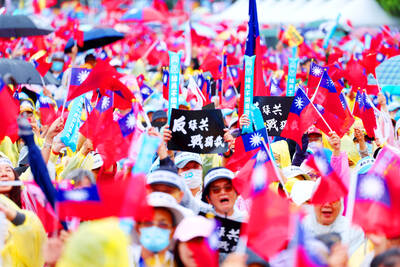The Year of the Dragon carries significance in Chinese societies as it symbolizes power, success and luck, and this holiday can be a perfect time for a trip in search of the legendary creature in Taipei.
While temples abound in dragon sculptures, the Grand Hotel may be a good place to start, with the landmark structure on Yuanshan featuring more than 210,000 dragons in different shapes and styles.
Carvings of the legendary creature can be found on the rooftop, columns, ceiling and walls, but what has attracted the attention of most tourists and hotel guests alike is the sculpture sitting in the Golden Dragon Hall on the second floor.

Photo: Mo Yan-chih, Taipei Times
The dragon sculpture is what remains of the temple that used to sit on the site of the current Grand Hotel. The temple, known as the Taiwan Shrine, was destroyed during World War II. How the brass dragon sculpture survived the war has become a local legend, and residents have come to worship the dragon and pray for good fortune.
The so-called “dragon-tail cave” was later selected by Soong May-ling (宋美齡) to build the hotel in 1952. According to Feng Chi-wei (馮志偉), a public relations specialist at the hotel, the brass dragon continued to be a popular attraction among hotel guests, especially from Japan and China, who would visit the spot and worship the dragon.
Feng said the 100-year-old brass dragon was different from traditional Chinese-style dragons as it only has three claws, rather than five, and therefore the dragon could be a work of the Japanese during the colonial period.

Photo: Mo Yan-chih, Taipei Times
The hotel plated the brass dragon with gold in 1987 during its renovation and plated it again last year to enhance its luster for the Year of the Dragon, he added.
Another refined decoration featuring dragons in the hotel is the plum-blossom shaped sculpture in the lobby’s ceiling. The intricate artwork features 28 dragons and 16 phoenixes as a symbol of fortune.
Downhill from the hotel is another great spot to search for dragons — Bao-an Temple (保安宮). Located in the Dalongdong (大龍峒) area, Bao-an Temple is one of the three major temples in Taipei — along with Longshan Temple (龍山寺) and Master Chingshui Temple (清水祖師廟). The structure of the temple is known for its grand scale and refined carvings, with colorful dragons situated on the rooftops.
The four dragon columns in front of the temple feature dragons carved out of octagon columns, and the stone sculpture is a fine representation of Qing Dynasty art in the 1800s.
Another temple with grand dragon sculptures that should not be missed is Longshan Temple in Wanhua District (萬華). Built in 1738, the temple is a center of worship for Guanyin, or the goddess of mercy, among other deities. As one of the major Buddhist temples in Taiwan, Longshan demonstrates the best in traditional Chinese temple architecture.
According to Longshan’s management, it is the only temple in Taiwan that features bronze dragons on both its right and left pillars at the main entrance — a symbol of the dragons’ protection of the main hall.
The rooftops of the temple are decorated with dragons and phoenixes pasted with colorful glass and ceramics, adding vigor to the solemn temple.
Both Bao-an and Longshan Temple are listed as Class 2 monuments with structures well-preserved in ancient forms, and both are top choices for observation of Chinese-style dragon sculptures or icons, said Angel Chen (陳譽馨), a division chief at Taipei City’s Department of Information and Tourism.
Chen suggested that visitors, on the sideline of the dragon trip, could also sample traditional Taiwanese food near the temples — from sweet porridges to braised pork rice.
“Visiting temples to worship and pray for good fortune is a local tradition during the Lunar New Year, and for the Year of the Dragon, taking some time to enjoy the refined dragon sculptures while praying should be great,” she said.
For a great festive atmosphere and modern-style dragons, the annual Lantern Festival in Taipei presents dragons in creative and animated forms.
The festival, which runs from Feb. 2 to Feb. 12, will feature a giant dragon-shaped lantern at the Sun Yat-sen Memorial Hall’s main lantern area. Aside from the main lantern, titled “Happy Dragon,” visitors can also view dragons in the “Fish Leaping the Dragon Gate” area at the hall, where a fusion of real and virtual lanterns depict folk legends about dragons.
Visitors can get a sneak preview of the festival on Jan. 30 at the lantern-lighting trial run, according to Taipei City’s Department of Civil Affairs.
Following visits to dragons around the city, a trip to an exhibition on dragons at Taipei Zoo would be a great way to end the trip.
The exhibition, which runs through Jan. 30, includes displays of relics of dinosaur eggs, pictures and stories about dragons.
Organizer Tang Hsin-jie (唐欣潔) said the exhibition gives an interesting background to the legendary creature, such as the origin of the noblest animal in Chinese legend, which is a combination of a camel’s head, eagle’s claws, snake’s neck, rabbit’s eyes, bull’s ears, and scales of carp.
Many zoologists believe that the crocodile is the primary form of Chinese dragons, and visitors can check out crocodiles or alligators in the zoo, Tang added.
The zoo, which was closed yesterday, reopens today.

PRAISE: Japanese visitor Takashi Kubota said the Taiwanese temple architecture images showcased in the AI Art Gallery were the most impressive displays he saw Taiwan does not have an official pavilion at the World Expo in Osaka, Japan, because of its diplomatic predicament, but the government-backed Tech World pavilion is drawing interest with its unique recreations of works by Taiwanese artists. The pavilion features an artificial intelligence (AI)-based art gallery showcasing works of famous Taiwanese artists from the Japanese colonial period using innovative technologies. Among its main simulated displays are Eastern gouache paintings by Chen Chin (陳進), Lin Yu-shan (林玉山) and Kuo Hsueh-hu (郭雪湖), who were the three young Taiwanese painters selected for the East Asian Painting exhibition in 1927. Gouache is a water-based

A magnitude 4.1 earthquake struck eastern Taiwan's Hualien County at 2:23pm today, according to the Central Weather Administration (CWA). The epicenter of the temblor was 5.4 kilometers northeast of Hualien County Hall, at a depth of 34.9 km, according to the CWA. The earthquake's intensity, which gauges the actual effect of a temblor, was the highest in Hualien County, where it measured 2 on Taiwan's 7-tier intensity scale. The quake also measured an intensity of 1 in Yilan county, Taichung, Nantou County, Changhua County and Yunlin County, the CWA said. There were no immediate reports of damage or injuries.

OFF-TARGET: More than 30,000 participants were expected to take part in the Games next month, but only 6,550 foreign and 19,400 Taiwanese athletes have registered Taipei city councilors yesterday blasted the organizers of next month’s World Masters Games over sudden timetable and venue changes, which they said have caused thousands of participants to back out of the international sporting event, among other organizational issues. They also cited visa delays and political interference by China as reasons many foreign athletes are requesting refunds for the event, to be held from May 17 to 30. Jointly organized by the Taipei and New Taipei City governments, the games have been rocked by numerous controversies since preparations began in 2020. Taipei City Councilor Lin Yen-feng (林延鳳) said yesterday that new measures by

‘WORSE THAN COMMUNISTS’: President William Lai has cracked down on his political enemies and has attempted to exterminate all opposition forces, the chairman said The legislature would motion for a presidential recall after May 20, Chinese Nationalist Party (KMT) Chairman Eric Chu (朱立倫) said yesterday at a protest themed “against green communists and dictatorship” in Taipei. Taiwan is supposed to be a peaceful homeland where people are united, but President William Lai (賴清德) has been polarizing and tearing apart society since his inauguration, Chu said. Lai must show his commitment to his job, otherwise a referendum could be initiated to recall him, he said. Democracy means the rule of the people, not the rule of the Democratic Progressive Party (DPP), but Lai has failed to fulfill his